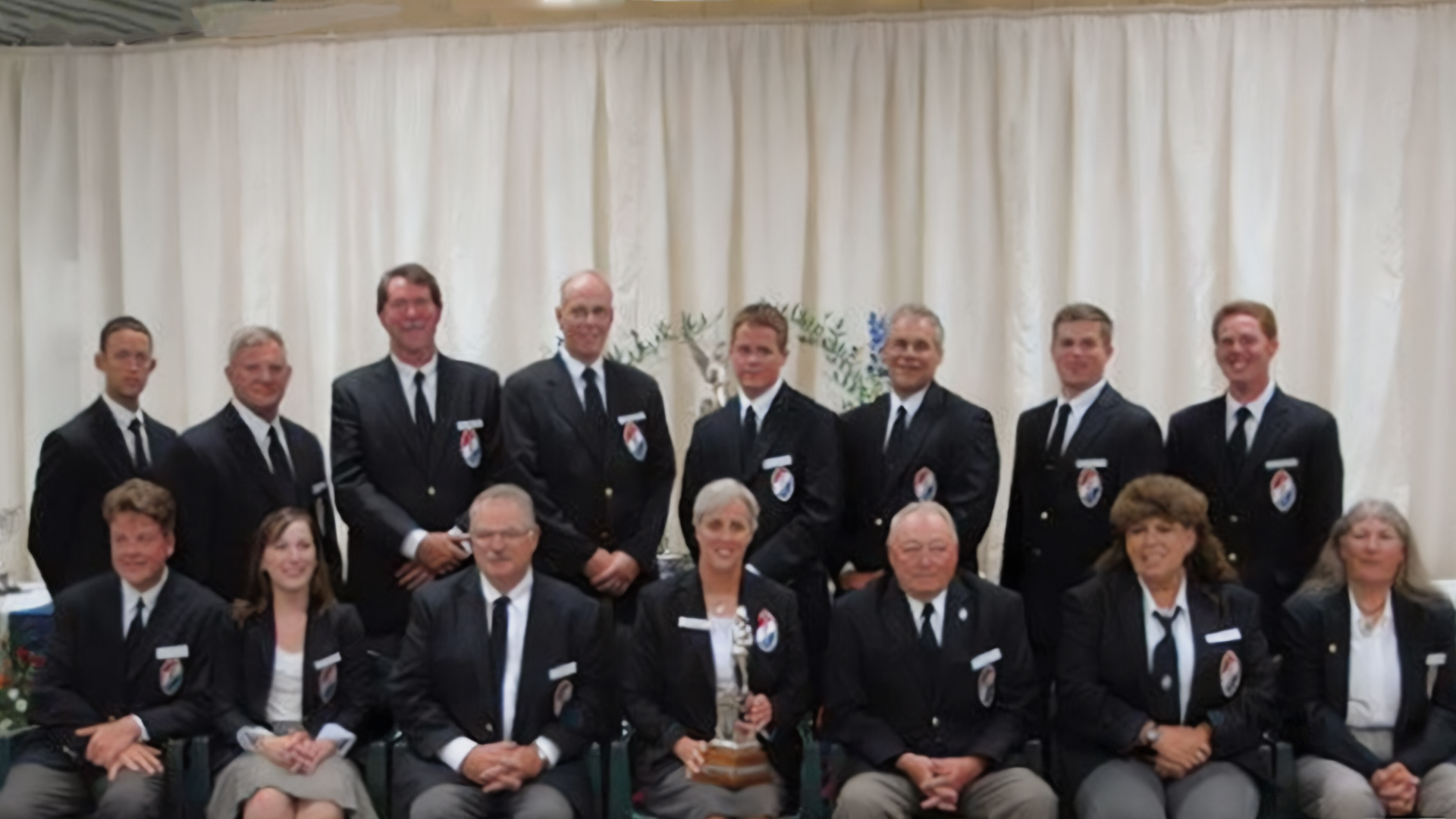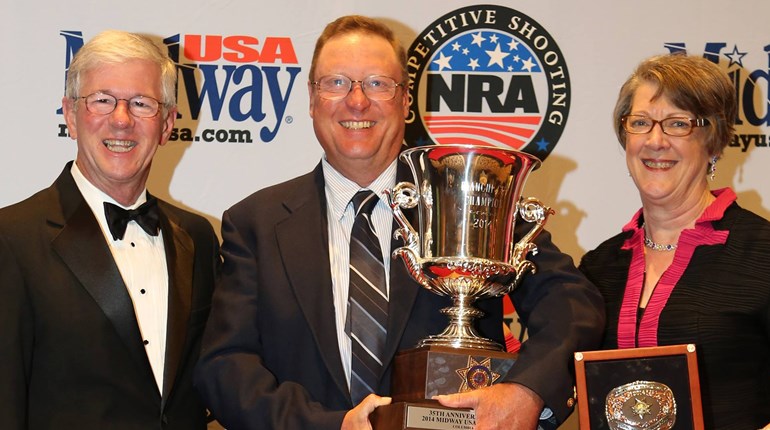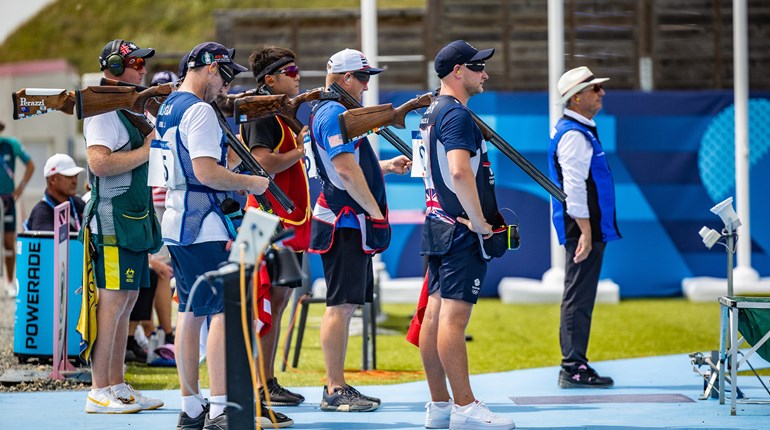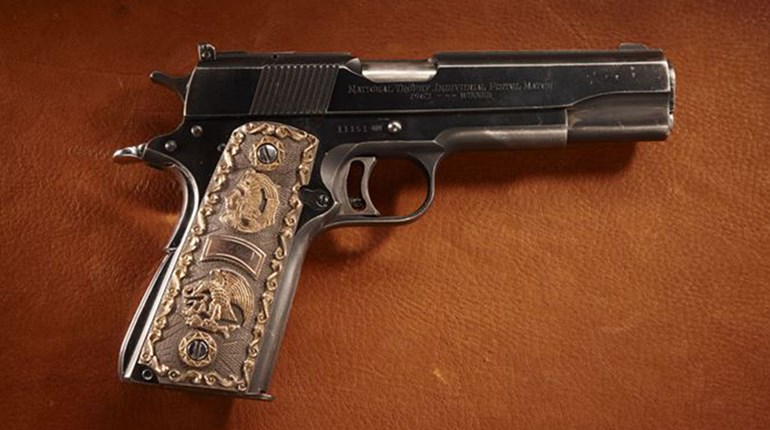
From the vault: A match report by the late Hap Rocketto about the 2009 Roberts Team Match held at the National Matches at Camp Perry that year. As published in the January 2010 issue of Shooting Sports USA.
2009 Roberts Team Matches
By Hap Rocketto
The shoulder-to-shoulder match series between the United States and Great Britain originated in 1931 when the National Rifle Association, slightly cocky from a long string of victories in the Lord Dewar International Postal Match, issued a challenge to Great Britain’s Society of Miniature Rifle Clubs for a shoulder-to-shoulder rifle match to be shot in England. As the prize, the Americans offered up the Pershing Trophy donated by General of the Armies John J. Pershing, a Distinguished Marksman himself.
The United States team traveled to Great Britain in 1931 and was defeated. Because of the Great Depression, the series was not resumed until 1937 when Great Britain won again. In the third match, just weeks before the outbreak of World War II in September of 1939, the United States finally won.
The Pershing Trophy Match series resumed in 1953 and was fired next in 1961 and 1965. Noted British rifleman Col. Thomas Sutton, a veteran of the first Pershing Trophy match in 1931, donated The Field Marshall Earl Roberts Trophy in 1969. Roberts, like Pershing, was a major military figure who supported marksmanship.
A shoulder-to-shoulder international match would now be held every four years, with the location alternating between the United States and Great Britain. A team from Canada also participates in the Pershing Trophy Match, which is shot in the United States. Only Great Britain and the United States contend for the Roberts Trophy, which is fired in England.
The United States began mounting its 2009 defense of the Roberts Trophy at the 2008 Prone Championship. The top 12 shooters in the metallic sight championship were selected as the preliminary team with the next placing competitors designated as alternates. Over the course of the following year, the roster settled to Davis Cramer, Kimberly Chrostowski, Mark DelCotto, Glenn Dubis, Paul Gideon, Hank Gray, Tarl Kempley, Virginia McLemore, Kevin Nevius, Dave Sprecher, Nancy Tompkins and Justin Tracy as shooters under the leadership of Team Captain Edie Fleeman, Coach Lones Wigger and Adjutant Hap Rocketto.
Accompanying the United States Roberts Team was the Goodwill Randle Team with Michele Bohren, Mary Chappelear, Reya Kempley and Lenore Lemanski and led by Team Captain Martha Kelley and Coach Bobbi Vitito. Jeff Doerschler and Steve Rocketto also made the trip as independent riflemen, as did a host of team dependents.
Robert Loughridge, vice chairman of Britain’s National Smallbore Rifle Association (NSRA), met the United States teams in England to shepherd them through customs and then lead the four-vehicle caravan to the team’s lodgings. After checking in, the team moved on to Bisley to deposit their rifles in the armory and receive a briefing on match procedures by Geoff Doe, director of shooting for the NSRA and George Lawton, the chief range officer.
The following day was devoted to adjusting for jet lag and acclimating to the new surroundings. The day was capped by a meet-and-greet buffet hosted by the NSRA at the Roberts Centre, a multi-purpose building that houses the association’s offices and the Malcolm Cooper Range, as well as a swimming pool and hockey rink. The event brought the two teams together for the first time.
The teams jumped into competition the next day by entering the “Weekend Aggregate,” 40 shots at 50 yards and 40 shots at 100 yards. The ladies used these events as a warm up for the Randle Goodwill Match, which was scheduled for that afternoon. While winning was always on their minds, the real purpose of these two matches was to shake down equipment and shooter alike and to begin studying the Bisley range conditions.
The Randle Goodwill Team fielded Bohren, Chappelear, Chrostowski, Fleeman, McLemore and Kempley. With a shortage of women to fill all of the posts, former U.S. National Prone Champions Wigger, Nevius and Gideon were called upon as coaches. The team’s good effort was not enough, however, and the ladies came up short to a fine British team. In the tradition of good sportsmanship that has come to define these matches, the ladies’ teams enjoyed a gift exchange and light buffet after the match.
Monday saw the beginning of the 80th Bisley Smallbore Rifle Meeting. Over the next four days the competitors would deal with heat, mirage and the wind. Fortunately, there was only a trace of the notorious Bisley rain that has so often marked this event. The 280-shot course-of-fire consists of two 40-shot 50-yard matches, two 40-shot 100-yard matches, an English Match of 60-shots at 50 yards and a Scottish Match of 60-shots at 100 yards. There are also a series of optional matches that may be fired concurrently or separately. Entry into the optional matches is done by affixing an adhesive bar coded sticker to the target, giving them the euphonious name of “Sticker Matches.”
The first day concluded with a formal banquet sponsored by The Perrymen at the Army Target Shooting Club, one of the many colonial-style permanent buildings which dot the Bisley facility. The Perrymen is a group of British shooters who, in 1965, first competed at Camp Perry and formed an association to further Anglo-American shooting relations. After a sumptuous dinner and entertaining program, The Perrymen presented the U.S. Roberts Team with engraved crystal to mark the occasion.
The U.S. team continued to gain insight into the vagaries of the Bisley winds over the next several days. Wednesday was highlighted by a historic walking tour of Bisley conducted by Geoff Doe, a former British Champion, who virtually grew up on the grounds. There was also an opportunity to visit the National Rifle Association Museum, which contains a vast display of Bisley artifacts. The NSRA, which is the governing body for smallbore, and the centerfire oriented NRA are distinctly different organizations that both occupy Bisley.
On the eve of the Roberts Match, after four days of competition, the team and coaches were selected based on score and compatibility. After observing the various styles of shooting and coaching, Coach Wigger selected Captain Edie Reynolds to coach Ohio riflemen Gideon and Nevius; Adjutant Rocketto would read the wind for Dubis and fellow Rhode Islander Chrostowski, Army shooters Sprecher and Gray would shoot under Tracy, Cramer scoped for DelCotto and Kemply, with Wigger taking two fellow southwestern shooters, McLemore and Tompkins, as his pair.
Conditions were clear on match day with the wind huffing and puffing out of 10 o’clock with enough strength to make mirage a useless hindrance. At the end of the 50-yard stage, the British held a 1948 to 1935 lead. This 13-point difference may well have been a result of a malfunctioning rifle, as the lowest scoring U.S. shooter fired well below his weekly average for that yard line. It also cast a shadow across the U.S. efforts as there was no longer any room for error. A sterling performance at long-range would be required to win.
A mental lapse at the 100-yard line saw one U.S. rifleman shoot 22 rounds (instead of the requisite 20) into his record bullseye, virtually slamming the door on any hopes for a comeback. The host team came to the fore at 100 yards and simply outshot the U.S., 1894 to 1871. The final score of 3842 to 3806 was the largest difference since the first Roberts Trophy match in 1965. In typical British decorum, our hosts diplomatically stated that, “The scores were relatively low, reflecting the windy conditions, and as a result, the margin of victory, 36 points, was larger than would normally have been expected.”
With the sixth Field Marshall Earl Roberts Trophy Match now in the record books, the NSRA hosted the U.S. team to another in the ongoing series of formal banquets.
Roberts Team Captain Edie Fleeman was honored to be chosen to present the awards, handing out all of the silver salvers, bowls, cups, ewers and trophies, as well as one Crusader Sword, which covered some 60 feet of table. Kempley, Nevius, Glenn and Michelle Dubis and Bohren were among those who accepted awards from her hands.
Soon after the prize giving, the U.S. hosted the final formal dinner in the Lord Roberts Center. Gifts were exchanged between the teams, a crystal plinth from the host to the visitors and, in return, a porcelain bald eagle and individual riflemen. The victors also received engraved pewter bowls from the vanquished.
After speeches, much toasting and story telling, Nevius entertained all with his accomplished playing on an electric keyboard. It was a splendid evening which no one wished to see end. With firm handshakes and heartfelt words of parting all around, the teams left in friendshipon when they will meet again to compete.


































